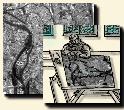 |
 |
![]()
Region growing calls upon a process similar to perceptual grouping. We can note two methods:
Both methods can be used jointly [A. Moghaddamzadeh, 1997] [D. Mckeown, 1984].
This type of processing can work on only one image and constitutes a simple means to detect homogeneous areas. Segmentation can
In the case of a processing based on homogeneity, the general principle
consists in selecting the pixels for which the radiometric difference with
its neighbours is lower than a given threshold:
The simple comparison often gives very partial results. The areas obtained are very split up, and it is necessary to amalgamate them thereafter. The sequence in the process of amalgam is often significant, and no rule makes it possible to choose in a sure way.
Softening threshold constraints seems an interesting approach, the introduction of fuzzy elements makes it possible to translate concepts such as ``almost the same color'', without caring about a strict threshold or a rigid tolerance beyond which the grouping process jams. Additive information brought by different sources and their fusion can constitute an improvement.
Thus, MOGHADDAMZADEH and BOURBAKIS [A.
Moghaddamzadeh, 1997] use in their algorithms the concept of fuzzy
contrast between two colors to segment RVB color images.
![]()